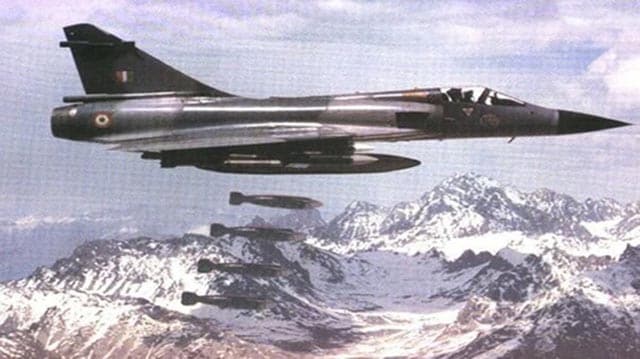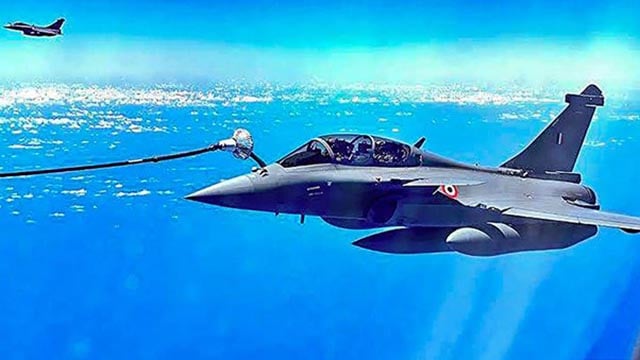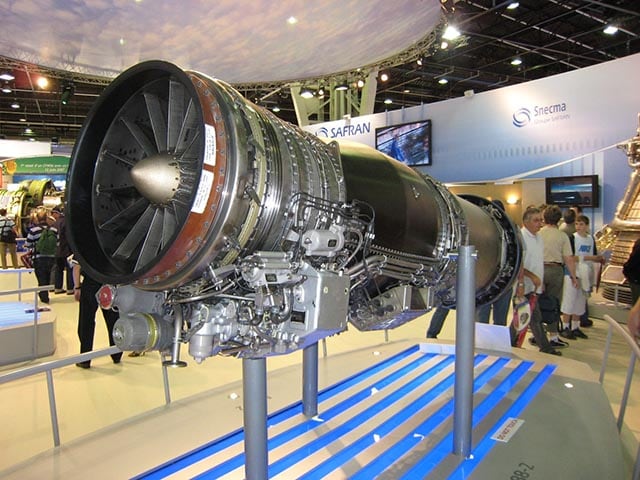Indian Prime Minister Narendra Modi is in France as the guest of honour at the Bastille Day Parade. There are plans to move forward in many areas of cooperation ranging from defence, security to energy. Three Rafale fighter jets of the IAF are taking part in the Bastille Day flypast over the Champs Elysees in Paris on 14 July, and a tri-services contingent is participating in the parade along with their French counterparts. There are events and actions that indicate the great bonhomie between the two friendly nations and strategic partners, and the chemistry between the leaders. But clearly, the loudest buzz is about the aviation deals. The visit may see the announcement of India purchasing 26 carrier-capable Rafale-M aircraft for the Indian Navy. India has been in talks with France’s Safran Group for joint development of a fighter aircraft engine for India’s fifth-generation fighter, the Advanced Medium Multirole Fighter Aircraft (AMCA). Hindustan Aeronautics Ltd (HAL) has already made the Turbomeca (a Safran company) supported ‘Shakti’ helicopter engine. Safran Helicopter Engines and HAL are now set to form a joint venture (JV) for developing an indigenous aero-engine for Indian Multirole Helicopter (IMRH), which will be built in large numbers in the near future. These deals if they go through, would take the relations between the two to the next higher level. Of course, there are also plans to announce the deal to make three additional Scorpene submarines in India. Indian Navy already operates six India-made Scorpene (Kalvari-class) submarines. France: India’s time-tested strategic partner Indo-French relations date back to 1674 when the French arrived in India at Pondicherry. They later created colonies at Pondicherry, Karikal, Yanam, Mahe and Chandanagar. All these were peacefully transferred to India in 1954. Paris and New Delhi have had warm and business-friendly relations from the very beginning. French supported India during the Cold War and also tacitly supported India as a nuclear power. India and France signed a strategic partnership in January 1998. French have been pioneers of world aviation. After WW II, aviation designer Marcel Dassault rebuilt the country’s aviation industry. The MD 450 ‘Ouragan’ was the first French-designed jet fighter to enter production. Military aviation is one of the most enduring solid pillars of the Indo-French relationship since the early 50s. [caption id=“attachment_12865092” align=“alignnone” width=“640”]
IAF Mystere on No.1 Squadron (Tigers). Image courtesy IAF Archives[/caption] The military aviation connect In June 1953, India ordered 71 French Dassault Ouragans (Indian name Toofani). Additional aircraft were bought in 1957, taking the total to 104. Toofanis saw combat action in 1961 Goa operations and flew reconnaissance missions in the 1962 Sino-Indian war. The fleet was replaced by another Dassault aircraft, the Mystere IVA in 1957. India procured 104 Mystere and used them extensively in the Indo-Pakistani War of 1965. On 7 September 1965, an Indian Mystere shot down a Pakistani Lockheed F-104 Starfighter during a raid over Sargodha. The fleet was phased out by 1973. Breguet Alize was a French carrier-based anti-submarine warfare aircraft. Twelve were acquired by Indian Navy and operated from aircraft carrier Vikrant. They took part in Goa operations and in the 1971 Indo-Pak war. Alizes operated till 1991. The Aerospatiale Alouette III a single-engine, French light utility helicopter was manufactured under license by HAL as ‘Chetak’. Two more versions, lighter ‘Cheetah’ and re-engined ‘Cheetal’ were later developed for high-altitude operations including the Siachen glacier. Over 300 were built and many are still in service in the Indian Armed Forces and Coast Guard. [caption id=“attachment_12865112” align=“alignnone” width=“640”] IAF Cheetah Helicopter in Siachen Glacier. Image courtesy IAF[/caption] After a lull in the Cold War years, the Indo-French aerospace linkage got re-established when IAF purchased the British-led, Anglo-French jaguar Deep Penetration Strike Aircraft (DPSA) in the seventies. IAF later bought a pure French aircraft when they purchased 49 Mirage 2000s in the 1980s. Ten more were bought in 2004. The Mirage 2000 was the first fly-by-wire controlled aircraft of the sub-continent. Its weapon-integrated multi-mode radar gave the Indian Air Force (IAF) look-down/shoot-down capabilities. The aircraft brought IAF’s first Beyond Visual Range (BVR) missile the Super R530 F/D and the all-aspect capable Magic 2 missile. IAF got the first comprehensive EW suite on any aircraft with a self-protection jammer, radar warning receiver, chaff and flare dispenser, an escort jammer and an ELINT Pod. Mirage 2000 performed exceedingly well in the 1999 Kargil conflict. The battle took place over some of the highest terrain in the world, where both the aircraft and weapons were closer to the edges of the envelope. Laser-guided bombs were used against reinforced targets. A very high sortie generation rate made the Mirage 2000 one of the most efficient fighters of the IAF. The aircraft was later upgraded to the Mirage 2000-5 Mk 2 standards and had improved avionics, a glass cockpit and smarter weapons. Mirage-2000 was the platform of choice for the Balakot Strike in 2019 where it hit targets with the Spice-2000 precision glide bombs. [caption id=“attachment_12865152” align=“alignnone” width=“640”]
 Mirage-2000 over Kargil. Image courtesy IAF[/caption] Rafale the game changer The purchase of 36 Dassault Rafale was announced during Prime Minister Modi’s visit to France in 2015. The aircraft purchased in a government-to-government (G2G) are now fully operational in two fighter squadrons of the IAF. The twin-engine, fly-by-wire, omni-role fighter can do multiple missions in the same flight, simultaneously flying air superiority, reconnaissance, interdiction, and airborne nuclear deterrent missions. The aircraft has partial stealth features, with reduced radar cross-section (RCS) and low infrared signature. The aircraft is powered by two Safran Snecma M88 engines. A thrust vectoring variant of the engine designated as M88-3D is also under development. The aircraft’s RBE2 AA active electronically scanned array (AESA) radar has already been operationally tested. The SPECTRA integrated electronic warfare suite provides long-range detection, identification and accurate localization of infrared homing, radiofrequency and laser threats. The system incorporates a radar warning receiver, laser warning, and missile approach warning (MAW) features. The aircraft’s 14 hard points can carry 9,500 kg external loads. The air-to-air missiles include MBDA MICA and Meteor. Meteor BVR offers multi-shot capability against long-range manoeuvring targets, jets, UAVs and cruise missiles in a heavy electronic countermeasures (ECM) environment with a range well in excess of 150 kilometres. The no-escape zone of over 60 km is the largest among air-to-air missiles according to the manufacturer. Among the host of air-to-ground weapons is the MBDA Storm Shadow/SCALP-EG cruise missile with a 450 kg warhead and 560 km range. The 60-kilometre range HAMMER (Highly Agile Modular Munition Extended Range) can be fitted on 125 to 1,000 kg bombs. The Rafale has been used in combat in Afghanistan, Libya, Mali, Iraq and Syria. The aircraft is a game-changer and will help India dominate both the Himalayas and Indian Ocean Region (IOR). They have recently flown extended-range deep-sea missions and are regularly operating over the Himalayas. [caption id=“attachment_12865182” align=“alignnone” width=“640”]
Mirage-2000 over Kargil. Image courtesy IAF[/caption] Rafale the game changer The purchase of 36 Dassault Rafale was announced during Prime Minister Modi’s visit to France in 2015. The aircraft purchased in a government-to-government (G2G) are now fully operational in two fighter squadrons of the IAF. The twin-engine, fly-by-wire, omni-role fighter can do multiple missions in the same flight, simultaneously flying air superiority, reconnaissance, interdiction, and airborne nuclear deterrent missions. The aircraft has partial stealth features, with reduced radar cross-section (RCS) and low infrared signature. The aircraft is powered by two Safran Snecma M88 engines. A thrust vectoring variant of the engine designated as M88-3D is also under development. The aircraft’s RBE2 AA active electronically scanned array (AESA) radar has already been operationally tested. The SPECTRA integrated electronic warfare suite provides long-range detection, identification and accurate localization of infrared homing, radiofrequency and laser threats. The system incorporates a radar warning receiver, laser warning, and missile approach warning (MAW) features. The aircraft’s 14 hard points can carry 9,500 kg external loads. The air-to-air missiles include MBDA MICA and Meteor. Meteor BVR offers multi-shot capability against long-range manoeuvring targets, jets, UAVs and cruise missiles in a heavy electronic countermeasures (ECM) environment with a range well in excess of 150 kilometres. The no-escape zone of over 60 km is the largest among air-to-air missiles according to the manufacturer. Among the host of air-to-ground weapons is the MBDA Storm Shadow/SCALP-EG cruise missile with a 450 kg warhead and 560 km range. The 60-kilometre range HAMMER (Highly Agile Modular Munition Extended Range) can be fitted on 125 to 1,000 kg bombs. The Rafale has been used in combat in Afghanistan, Libya, Mali, Iraq and Syria. The aircraft is a game-changer and will help India dominate both the Himalayas and Indian Ocean Region (IOR). They have recently flown extended-range deep-sea missions and are regularly operating over the Himalayas. [caption id=“attachment_12865182” align=“alignnone” width=“640”] Rafale refuelling during a deep sea mission. Image courtesy IAF[/caption] Air exercises Exercise ‘Garuda’ series with the French Air and Space Force (FASF) began in 2003 at Air Force Station Jodhpur, India. Subsequently, they were held in 2005, 2006, 2010, 2014, and 2019. The other locations included Istres and Mont-de-Marson in France and Kalaikunda in India. French and Indian Rafale fighter aircraft, French A-330 Multi Role Tanker Transport (MRTT) aircraft, Indian Su-30 MKI, LCA Tejas, Jaguar fighter aircraft, the Light Combat Helicopter (LCH), and Mi-17 helicopters have participated. IAF also fielded combat-enabling assets like Flight Refuelling Aircraft (FRA) and AEW&C. The joint exercises were meant to augment the “operational capability and interoperability, while also sharing best practices.” In August 2022, a contingent of the FASF made a strategically important stop at the IAF’s Sulur base in Tamil Nadu on their way to Exercise Pitch Black 2022 in Australia. Aero-Engine connection India already has experience in the manufacture, overhaul and maintenance of Turbomeca Artouste IIIB and the HAL/Turbomecca TM 333-2M2 Shakti engine for helicopters. The Mirage 2000 was initially powered by the M53-5, and later with more powerful M53-P2. These are being fully maintained and overhauled in India. The Rafale is fitted with two Snecma M88 engines. All these are Safran group engines. Both the IAF and HAL have worked closely with French companies and are very well-versed with the French fighter and helicopter engine technologies, and working culture. India has already chosen the GE-414 for LCA Mk2 and the same will be produced in India. At best India will get production technology transfer with that engine, as the engine is already fully developed. India still needs its own home-designed engine with intellectual property rights. Though India’s GTRE ‘Kaveri’ may not have seen sufficient success there is a wealth of experience gained, experienced skilled designers and manpower, and data available. A joint venture with Safran could ensure that India has its own engine for the indigenous fifth-generation AMCA. It will cost money, but then India must pay if it one day wants to sit on the global defence-manufacturing high table. The details of the deal will evolve in due course of time. [caption id=“attachment_12865292” align=“alignnone” width=“640”]
Rafale refuelling during a deep sea mission. Image courtesy IAF[/caption] Air exercises Exercise ‘Garuda’ series with the French Air and Space Force (FASF) began in 2003 at Air Force Station Jodhpur, India. Subsequently, they were held in 2005, 2006, 2010, 2014, and 2019. The other locations included Istres and Mont-de-Marson in France and Kalaikunda in India. French and Indian Rafale fighter aircraft, French A-330 Multi Role Tanker Transport (MRTT) aircraft, Indian Su-30 MKI, LCA Tejas, Jaguar fighter aircraft, the Light Combat Helicopter (LCH), and Mi-17 helicopters have participated. IAF also fielded combat-enabling assets like Flight Refuelling Aircraft (FRA) and AEW&C. The joint exercises were meant to augment the “operational capability and interoperability, while also sharing best practices.” In August 2022, a contingent of the FASF made a strategically important stop at the IAF’s Sulur base in Tamil Nadu on their way to Exercise Pitch Black 2022 in Australia. Aero-Engine connection India already has experience in the manufacture, overhaul and maintenance of Turbomeca Artouste IIIB and the HAL/Turbomecca TM 333-2M2 Shakti engine for helicopters. The Mirage 2000 was initially powered by the M53-5, and later with more powerful M53-P2. These are being fully maintained and overhauled in India. The Rafale is fitted with two Snecma M88 engines. All these are Safran group engines. Both the IAF and HAL have worked closely with French companies and are very well-versed with the French fighter and helicopter engine technologies, and working culture. India has already chosen the GE-414 for LCA Mk2 and the same will be produced in India. At best India will get production technology transfer with that engine, as the engine is already fully developed. India still needs its own home-designed engine with intellectual property rights. Though India’s GTRE ‘Kaveri’ may not have seen sufficient success there is a wealth of experience gained, experienced skilled designers and manpower, and data available. A joint venture with Safran could ensure that India has its own engine for the indigenous fifth-generation AMCA. It will cost money, but then India must pay if it one day wants to sit on the global defence-manufacturing high table. The details of the deal will evolve in due course of time. [caption id=“attachment_12865292” align=“alignnone” width=“640”] Safran M-88 Fighter Aero-engine. Image courtesy Safran[/caption] Way ahead With the IAF down to 31 squadrons, its edge over Pakistan Air Force (PAF) has reduced from 3:1 to an all-time low of 1.5:1. Gap with the Chinese PLAAF is widening. In view of the two-front threat, and to get back to the authorised 42 squadrons quickly, IAF has been pushing the case to purchase 114 new fighters. These are required, as the LCA and AMCA programmes are still evolving and will take time. The country seems to have decided to acquire 26 Rafale-M for the Indian Navy. 36 Rafale are already operating with the IAF. India has also paid for one-time India-specific enhancements and has an airbase and technical infrastructure for additional squadrons. Instead of acquiring yet another type of fleet, India may wish to acquire the Rafale for those 114 aircraft for the make-in-India deal. Delhi considers France as the more reliable Western ‘friend’. India has a huge fleet of Airbus civil aircraft. India has now decided to convert pre-used, ex-Air India, Airbus A321 and A319 aircraft into IAF’s new airborne early warning and control (AEW&C) and flight refuelling aircraft (FRA). The airframe modifications for both will be done by the OEM. The engine joint venture with Safran, if successful, will be a game-changer. The time to decide and act is now, lest we miss the flight again. The writer is Director General, Centre for Air Power Studies. Views expressed are personal. Read all the
Latest News ,
Trending News ,
Cricket News ,
Bollywood News , India News and
Entertainment News here. Follow us on
Facebook,
Twitter and
Instagram.
Safran M-88 Fighter Aero-engine. Image courtesy Safran[/caption] Way ahead With the IAF down to 31 squadrons, its edge over Pakistan Air Force (PAF) has reduced from 3:1 to an all-time low of 1.5:1. Gap with the Chinese PLAAF is widening. In view of the two-front threat, and to get back to the authorised 42 squadrons quickly, IAF has been pushing the case to purchase 114 new fighters. These are required, as the LCA and AMCA programmes are still evolving and will take time. The country seems to have decided to acquire 26 Rafale-M for the Indian Navy. 36 Rafale are already operating with the IAF. India has also paid for one-time India-specific enhancements and has an airbase and technical infrastructure for additional squadrons. Instead of acquiring yet another type of fleet, India may wish to acquire the Rafale for those 114 aircraft for the make-in-India deal. Delhi considers France as the more reliable Western ‘friend’. India has a huge fleet of Airbus civil aircraft. India has now decided to convert pre-used, ex-Air India, Airbus A321 and A319 aircraft into IAF’s new airborne early warning and control (AEW&C) and flight refuelling aircraft (FRA). The airframe modifications for both will be done by the OEM. The engine joint venture with Safran, if successful, will be a game-changer. The time to decide and act is now, lest we miss the flight again. The writer is Director General, Centre for Air Power Studies. Views expressed are personal. Read all the
Latest News ,
Trending News ,
Cricket News ,
Bollywood News , India News and
Entertainment News here. Follow us on
Facebook,
Twitter and
Instagram.
One of the most enduring solid pillars of the Indo-French relationship since early 50s has been that of military aviation
Advertisement
End of Article


)

)
)
)
)
)
)
)
)



